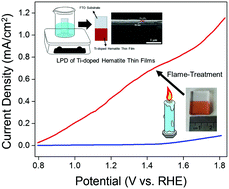Candle flame-treatment as an effective strategy to enhance the photoelectrochemical properties of Ti-doped hematite thin films†
Abstract
Flame-treatment as a simple, low cost, and highly reliable strategy was applied to effectively enhance the photoelectrochemical (PEC) properties of liquid phase deposited Ti-doped hematite thin films. The samples were heat-treated in three steps: 2 hours at 600 °C, one minute at 800 °C, and then 90 seconds in the flame of a paraffin wax candle. The microstructure studies revealed that the granular – morphology of the films depends on Ti doping levels and varies from acicular-like for the undoped and 1% Ti doped to spherical-like for 2–4% Ti, and then to warm-like morphology for 5% Ti-doped samples. The optical band-gap energy values of the samples decreased from 1.94 eV for the undoped to 1.53 eV for the 4% Ti-doped sample. The PEC investigations showed that heat-treatment in the candle flame effectively enhanced the photocurrent density, with an about thirteen-fold increase compared to the non-flame-treated sample. The photocurrent density was also increased by the Ti-doping level up to 4% and then declined for the sample with a 5% Ti-doping level. The highest photocurrent density was obtained as about 1.01 mA cm−2 at 1.8 V vs. RHE, about 14 times higher than that of the pure sample. Mott–Schottky analysis indicated that the donor concentrations and flat-band potentials are 2.65 × 1017 cm−3 and 0.42 V vs. RHE for the undoped sample and 1.2 × 1018 cm−3 and 0.47 V vs. RHE for the sample with 4% Ti-doping. The obtained PEC properties were also confirmed by electrochemical impedance spectroscopy. Our investigations demonstrated that upon candle-flame treatment, oxygen vacancies are introduced into the lattice of hematite thin films, which activate Ti-doping and act as electron donors.



 Please wait while we load your content...
Please wait while we load your content...